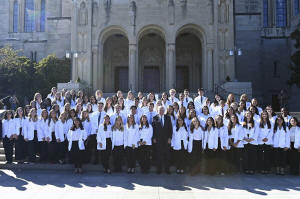Carlyle Group co-founder Bill Conway’s $1 billion plan to end the
nursing shortage
 [February 26, 2025]
By MARIA DI MENTO of The Chronicle of Philanthropy [February 26, 2025]
By MARIA DI MENTO of The Chronicle of Philanthropy
Bill Conway didn’t start out wanting to make a big impact on the nursing
profession.
In 2011, the financier announced he would give away $1 billion to create
jobs for the poor and asked the public to send him ideas. In came around
2,500 suggestions. Most were sob stories, but some people had good
ideas, he says, and several suggested backing bachelor’s degree nursing
programs.
“It was along the lines of: If we support potential students to get a
nursing degree, then they’ll always be able to get a job and take care
of themselves, their families, and the rest of us,” remembers Conway.
“My wife and I thought that sounded pretty good.”
Currently, private giving for the nursing profession accounts for only
one cent of every dollar given for health care, according to a report
from the foundation arm of the American Nurses Association. And giving
to nursing isn’t a popular cause among most wealthy donors.
But there are exceptions. Leonard Lauder has given $177 million to
nursing schools at the University of Pennsylvania and Hunter College,
and Mark and Robyn Jones donated $100 million to expand Montana State
University’s nursing program. Yet no other wealthy donor has dedicated
as much money to such a wide range of nursing programs as Conway, the
75-year-old co-founder of the private equity giant the Carlyle Group,
and his late wife, Joanne Barkett Conway, who died in January, 2024.
Those efforts are destined to grow, with Conway only about a third of
the way toward his target of giving $1 billion to nursing. So far, he
has donated $325.6 million to support student aid, new buildings,
efforts to recruit and retain faculty, and more at 22 nursing schools in
the Eastern and mid-Atlantic regions. He also is backing a pediatric
nursing program at Children’s National Hospital, in Washington, D.C.

Over the past decade, that money has helped produce more than 7,000
nurses. Now, he says, he wants to take his support of nursing programs
nationwide.
“I expect that of most of the money I leave to charity will go to
continuing this mission,” says Conway, whose net worth Forbes estimates
at $4 billion. “I see that we’re starting to make a difference in some
places, and I’d like to make more of a difference over time.”
Faculty shortage
America’s nursing shortage is misunderstood, says Linda Aiken, a
professor at the University of Pennsylvania’s nursing school. The public
hears about a nursing shortage and thinks there are not enough nurses or
people who want to become nurses, but the problem is more complicated
than that, she says.
While nurses are the largest group of health care professionals and the
backbone of health care, their contributions are frequently undervalued
by health care systems, and many are underpaid and experience a higher
rate of burnout than other medical professionals, according to Aiken and
other nursing experts.
Many more people want to become nurses than there are spots available in
nursing schools because there are not enough nursing professors. As a
result, nursing schools can accept few of the students who apply.
In 2022, roughly 78,000 qualified applicants were not accepted to U.S.
nursing schools because of insufficient faculty, classrooms and lab
space, according to the American Association of Colleges of Nursing.
There are also about 2,000 full-time nursing faculty vacancies at U.S.
nursing schools, says Katie Fioravanti, director of the foundation arm
of the American Association of Colleges of Nursing.
“Attracting people to teach nursing is challenging because they can make
considerably higher salaries in actual practice,” Fioravanti says. “By
the time they get a Ph.D. and go back to become a nursing faculty member
or a dean, they’re already in their 50s, and that means they retire
sooner.”

[to top of second column]
|

In this photo provided by The Catholic University, co-founder of The
Carlyle Group, Bill Conway, center, who plans to give $1 billion to
support nursing programs across the country, poses with nursing
students from The Catholic University of America in Washington, Oct.
18, 2024, one of the 22 nursing schools that his nonprofit currently
supports. (Patrick Ryan/The Catholic University of America via AP)
 Philanthropy by learning
The Conways didn’t know much about nursing when they decided to
donate to the field. With the help of a colleague whose wife was a
nurse, the couple began learning about the profession and university
nursing programs.
They first gave money to support tuition at nursing schools, largely
at the behest of Joanne Conway, a onetime scholarship student, and
because her husband wanted to ensure students graduated without the
burden of college debt.
“I wanted them to be free to be the kind of nurse they wanted to
be,” he says. “If they wanted to work in an inner-city clinic and
not make too much money or if they wanted to work someplace where
they were going to make a lot of money, I wanted them to do what
they wanted.”
Gradually, Conway supported building projects that expanded
classroom and lab space, the hiring of additional faculty, and
scholarships for nurses seeking advanced degrees to teach.
His giving process has mostly stayed the same. When Conway is
considering a first-time gift, he and the head of his Bedford Falls
Foundation, Elizabeth Carrott Minnigh, visit nursing schools, meet
with deans and ask for data related to graduation rates and nursing
licenses.
“We’re looking to see if it’s going to be a partnership where we
could fund a reasonably large number of students who would actually
get to the finish line without debt that will cripple them in their
career choices and opportunities,” Carrott Minnigh says.
Conway and Carrott Minnigh then visit the schools regularly to talk
to deans, faculty and students about any challenges they might be
facing. These conversations have often translated into more targeted
grants.
“We don’t have a one-size-fits-all grant-making process,” Carrott
Minnigh says. “It’s all customized to what we hear at the schools
about what they want and need.”
For example, in 2013, the Conways gave $4 million to Catholic
University’s nursing school. Since then, their giving to the
institution — now named the Conway School of Nursing — has grown to
more than $64 million, expanding full scholarships, largely paying
for a new nursing school building and backing graduate nursing
programs. The Conways also have supported mentoring efforts and a
review course to prepare students for the National Council Licensure
Examination for Registered Nurses.

“Calling his donations transformational is not saying enough,” says
Marie Nolan, dean of Catholic’s nursing school.
Over the past decade, Conway has also significantly funded the
University of Virginia’s nursing school. In 2013, he gave $5 million
for nursing scholarships and over time has donated nearly $50
million to expand scholarships for undergraduate and graduate
nursing programs, support nurses who want to become professors, and
help people pivot into nursing.
UVA’s nursing school’s dean, Marianne Baernholdt, says Conway’s
extensive giving to nursing programs, and particularly his efforts
to help nursing students early in their education, is rare among
wealthy donors.
“There are a couple of nursing schools that got big sums to increase
their advanced practice nursing programs,” Baernholdt says. “But
very few invest in pre-licensure, which is what the Conways have
done.”
All contents © copyright 2025 Associated Press. All rights reserved |